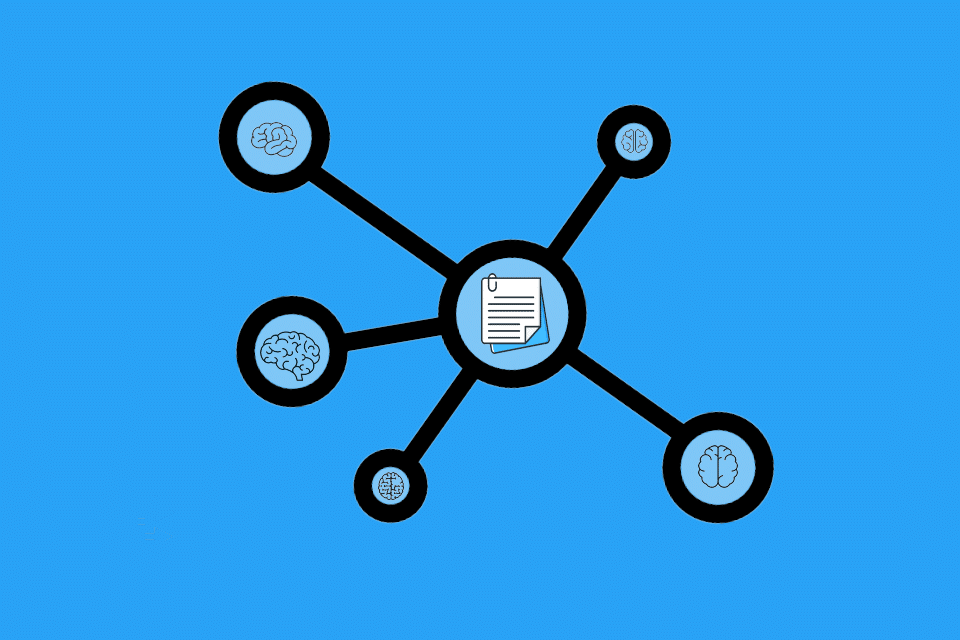What is Brain-Netting?
Smartpedia: Brain-netting is an online brainstorming format where idea generation is decentralised and can be preceded by online braindumping.
Brain-Netting – online brainstorming with online braindumping
Many people who used to work regularly in offices until a few years ago now carry out their activities in other places. They work in a home office, do workations or are active as so-called digital nomads. This is made possible by the internet, collaboration tools and the realisation that for many activities it is not important where they are carried out. As a result, new decentralised formats are needed that enable exchange – e.g. for solving problems or finding ideas. One such format is: brain-netting.
In its simplest form, brain-netting is an online brainstorming session. Brainstorming is a creativity technique in which a group of people work together to try to solve a task by collecting and developing ideas. The usual brainstorming rules also apply to brain-netting:
- Criticism of ideas and thoughts is forbidden to any participant (and thus also to the moderator or the minute-taker).
- There is no copyright on ideas. Ideas may be developed further together.
- A timebox is agreed, e.g. 45 minutes for brainstorming and 30 minutes for idea evaluation.
- Each participant can, but does not have to, contribute.
Brain-Netting can be supplemented or prepared by online braindumping. Braindumping describes the unloading of thoughts and ideas; whenever an idea on a topic arises, it can be immediately documented online, e.g. within a defined tool or with the help of a messenger, such as is available on every smartphone. The advantage of this upstream collection of ideas:
- Ideas do not get lost.
- Introverted people can contribute their ideas.
- And there is more time for the joint development and evaluation of ideas during the online brainstorming. (Perhaps a How-Now-Wow matrix could be useful for this as an evaluation aid).
Tips for conducting brain-nettings
In addition to the various tips for conducting online meetings, there are a number of tips for conducting brain-netting sessions.
- A place should be agreed upon to record the filing of ideas and thoughts. This can be an Etherpad, a channel or group in a messenger, a shared document on a server on the intranet, a whiteboard, etc. The possibilities are almost limitless. However, it is important that it is one place and not several that can be accessed online by all employees at any time.
- There should be a separate area per topic in the tool or in the filing location.
- Ideally, a standardised form of documentation should be agreed upon so that the respective ideas can be easily tracked.
- A common deadline is useful so that the facilitator has enough time before the online meeting to design a structure, group ideas or mark duplicates. Of course, new ideas may also be developed in the course of the online meeting. Here, too, a time box should be agreed upon.
- The ideas of other participants are taboo. They may be used in advance as input for your own ideas, but the original idea should not be alienated (e.g. partially deleted or reworded).
In practice, there are discussions in distributed teams, which may also be active in other time zones, as to whether all employees must participate in the online exchange. On the one hand, this would be recommended, but on the other hand, there are also constellations with teams that are active on three different continents. Each organisation should find the best solution for appropriate brain-netting.
Impulse to discuss
“Brain-Netting is also suitable for intoverted employees.” This is a central advantage of the approach. In the sense of documenting ideas, this is probably true, but does it also fit in terms of online exchange?
If you like the article or would like to discuss it, please feel free to share it in your network. And if you have any comments, please do not hesitate to send us a message.
Here you can find a German video about the advantages of braindumping.
Here you can download the Ideation Whitepaper free of charge. It explains many more practical methods of idea generation in detail.
And here you will find additional information from the t2informatik Blog:



